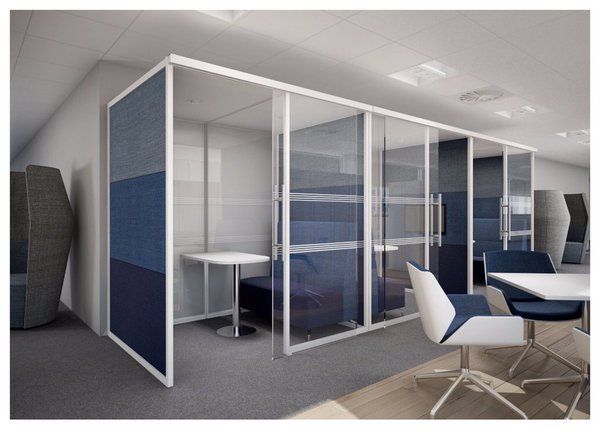Speech Privacy: Dealing with Work Environment and Legal Requirements

More Modern?
Or perhaps it’s a more modern office space, where the cube farm has been replaced by dog-bone tables, each populated with numerous t-shirt-clad software developers crowded around their laptops.
Maybe it’s in an old mill building or warehouse with a high, exposed ceiling.
What do these two office environments have in common? Very likely, they both have dissatisfied employees. The reason? Lack of speech privacy.
Those low cubicle walls you’re seeing aren’t doing anything to block the sound of the guy four cubes over talking loudly to his client.
Those glass walls and windows? The conversation from the two women in accounting about their weekend is echoing for the entire office to hear.
Most facility managers, HR managers and even IT managers recognize that noise distractions are a problem. They just aren’t aware there’s a solution to that problem.
And even if they are aware, they probably don’t know that their systems integrator is the person who can solve it.
In both cases, however, one of the most effective and efficient solutions to your clients’ noise problem is called sound masking, and it dovetails with other AV or cabling work you’re already implementing for your clients.
The Noise Problem
Recent studies have shown that lack of speech privacy is what’s really driving your client’s employees crazy. What’s speech privacy?
Simply put, it’s the inability of an unintentional listener to understand another person’s conversation. So, people with a lack of speech privacy are overhearing lots of conversations they shouldn’t be, which is, understandably, quite annoying to employees.
The Center for the Built Environment in San Francisco surveyed more than 25,000 workers in more than 2000 buildings to determine what the key environmental issues were for workers.
Of all the factors workers encounter in their office environment (general maintenance, layout, furnishings, thermal comfort, air quality and lighting), speech privacy was the factor they were the most dissatisfied with.
In addition, researchers at the University of Sydney recently discovered that lack of speech privacy is the number one complaint among cubicle workers and open-plan employees, with 60% and 50%, respectively, describing it as a major issue.
Employees are interrupted once every 11 minutes according to research from UC Irvine, and it takes them up to 23 minutes to get back into the flow of what they were doing before they were interrupted.
Costing Clients Money
Lack of speech privacy is also costing your clients money. In a study presented to the International Congress of Noise as a Public Health Problem, researchers found that, on average, employees waste 21½ minutes per day due to conversational distractions, making lack of speech privacy the number one cause of reduced productivity.
That’s roughly 4% of an average employee’s workday (based on an eight-hour day). Some quick math shows that a company with 100 employees and an average employee salary cost of $100,000 is losing $400,000 a year in productivity. Not exactly chump change.
A lack of speech privacy can lead to costly distractions, but also makes it possible for employees to overhear conversations they probably should not hear.
For example, as walls to private offices become cheaper and thinner, closing the door to an office no longer guarantees speech privacy (in fact, it’s probably worse because closing that door provides the illusion of privacy.)
Many private conversations could be HR nightmares if overheard by the wrong people (picture an HR manager talking to an employee about a sexual harassment complaint). And, in some cases, not providing sufficient speech privacy can even be illegal.
Medical offices need to provide speech privacy for conversations between doctors and patients in order to comply with HIPAA regulations, for example.
What Employers Can Do
Although everyone knows that office noise is a problem, few know that there’s a solution beyond giving every employee a private office or building higher cube walls. So what’s the solution? And more importantly, why should you care?
Sound masking is the solution. Although this technology has been around since the 1950s, the public at large is generally unaware of it.
In its simplest sense, sound masking is the process of adding a low level, unobtrusive background sound to an environment to reduce the intelligibility of human speech and reduce noise distractions.
It may sound counter-intuitive that adding noise to the environment would make it seem quieter, but the introduced noise, specifically tuned to the frequency and amplitude of human speech, covers up, or “masks,” excess speech noise and makes the acoustical environment more comfortable.
Sound masking doesn’t cancel speech; it simply decreases the distance a potential talker could be overheard. In most office environments, a worker could likely hear every word of another employee talking on the phone 40 feet away. With sound masking, that distance is shortened to about 15 feet.
Overheard speech is also less intelligible than it would be normally: A listener can often hear a conversation occurring, but can’t make out what’s being said. Unintelligible speech is much easier to ignore, so noise distractions are reduced.

Integrator Needed
So what does any of this have to do with you, systems integrators? Mainly, if your clients want sound masking in their office, you’re going to have to install it for them.
Although installing a direct-field sound masking system is not particularly difficult for a typical project manager or installer, it would be close to (if not completely) impossible for an end user to do it.
Installing a sound masking system generally involves cabling work above the ceiling tiles, and that’s not something your typical network administrator or office manager is interested in handling.
Additionally, even if your client is willing to install a sound masking system on their own, they wouldn’t be able to ensure that the sound emitted from the speakers is an effective masking sound (zoning, commissioning and tuning are probably terms you are familiar with, but it’s unlikely that your customers are).
What is an effective masking sound? Contrary to some misconceptions, sound masking is not “white noise.” White noise’s frequency is actually something that, when amplified, would be extremely unpleasant to listen to (think of a radio station playing nothing but static).
On the other hand, if created properly, sound masking noise will either be barely noticeable or will be pleasant sounding, similar to the sound of airflow through a vent.
Once the ideal sound masking frequency is established, it has to be amplified to the right level. Sound masking that’s too quiet won’t be effective, and sound masking that’s too loud will itself be distracting. The proper decibel level for sound masking is no louder than 48dBa.
In comparison, an office conversation between two people standing next to each other is about 60dBa. This ensures that sound masking will not affect the intelligibility of two people talking to each other, but will affect the ability of someone 10 to 15 feet away to be able to overhear the conversation.
Improper installation of sound masking will make sound masking ineffective at best and objectionable at worst.
Proper Zoning
Another factor to consider for creating an ideal sound masking sound is proper zoning. A sound masking system must be flexible enough to accommodate complex architectural spaces.
With changes in the size, volume, ceiling height, furnishings, etc., a masking system must also change in order to provide a consistent sound field.
This is done by incorporating zones into a design so the system is divided into smaller pieces, each of which can be tuned for that environment.
The easiest example of this is shown in the accompanying zoning diagram as an open office with private offices and corridor zones. Each of these environments differs from one another acoustically speaking (different walls, potentially different ceiling heights, etc).
Therefore, it’s imperative to be able to adjust the masking for each zone without affecting the other ones. A good sound masking system will allow for multiple zones that can be controlled through a centralized location.
Although commercial office spaces provide one of the most typical environments for sound masking, other industries also benefit from the technology.
Computer centers and libraries at educational institutions are perfect environments for sound masking because they are typically areas where students are trying to study and concentrate, and would welcome fewer noise distractions. Call centers benefit from sound masking by making it easier for employees to hear their calls and keep customer conversations private.
Financial institutions, such as commercial banks, find sound masking to be an effective way to keep sensitive financial data safe from prying ears.
And, as mentioned earlier, there are numerous use-cases of sound masking being helpful in the healthcare field, not only to ensure doctor-patient confidentiality, but to help patients in hospital rooms rest and recuperate with fewer noise distractions from busy areas surrounding them.
You may already be familiar with sound masking systems and installations, but if you aren’t, don’t fret. Sound masking systems range in complexity from those consisting of simply a module, cables and loudspeakers, to systems with dozens of components.
Some are easier to install and are more effective than others.
Some of the sound masking companies offer web-based sound masking certification programs (and some even provide CTS renewal units for those who complete them) that explain how sound masking works in greater detail and how their systems can be installed.
A quick web search for sound masking certification provides a few options. Each sound masking system on the market has its plusses and minuses; it’s really up to the installer and the end user to determine the system that’s best for them.
The one thing all of the systems have in common is that they require professional installation. This is where you come in.
Asking The Questions
Next time you’re doing an install, selling sound masking along with the other services you provide is a great way to solve a problem for your client while simultaneously creating a new business opportunity for yourself.
When you’re at the client’s office, do a quick site survey.
Are there a lot of cubicles? Are a lot of the employees wearing headphones? If so, these are usually good indicators that there’s a noise problem in the office.
Mentioning the solution to the problem (sound masking) to the client is not the best way to broach the subject because he unlikely won’t know what it is.
Instead, get your client talking about the noise problem in their office, then propose sound masking as the solution.
These questions generally get the conversation started:
• Do employees ever complain about being distracted by their co-workers?
• Do people raise concerns about their conversations being overheard?
• Can people in private offices hear conversations from other private offices?
• Can people in cubicles hear people in private offices?
• Is sensitive information being discussed?
• Do people keep their office doors closed because it’s too noisy?
• Is Human Resources located next to an area where they could be overheard?
• Is there a need to comply with HIPAA or GLBA regulations?
• Are clients/customers afraid of being overheard?
If the answer to any of these questions is yes, it’s a great opportunity to bring up sound masking and how it’s a relatively inexpensive solution to the problem.
Bringing up the fact that noise distractions are costing your clients money and making their employees crazy is also a compelling way to explain to them that they’ll be a hero for solving this problem, not just for their employees’ health and satisfaction, but for their company’s bottom line.
You, in turn, will be their hero for being the one who fixed their noise problem.
Credit- Mark Hughes
Source- http://www.soundandcommunications.com/speech-privacy-dealing-work-environment-legal-requirements/

